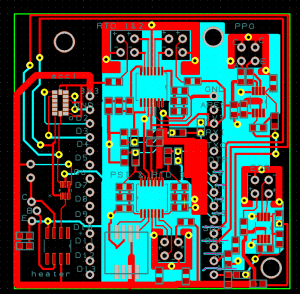With the prototype Psigasm up and running, I can’t help but get excited about how much better it could be. The next version is planned out pretty well in my head. I’ll be posting each step of turning those ideas into drawings and CAD files, and those into a physical device.
I just finished a draft of a PCB with measurement electronics for the Psigasm 2.0. It supports a pressure sensor, an accelerometer, three thermometers, a heater, a measurement of skin resistance, and an optical measurement of the skin reflectivity. If all of these sensors work properly, it will be capable of monitoring muscle contractions, heartrate, blood volume, blood volume pulse, moisture, heat capacity, and temperature of the external genital skin. All of these have been shown to link with the arousal cycle in interesting ways.
The board is designed to interface with the Arduino Fio. In case you are unfamiliar with Arduino, they are the state of the art in hobbyist microcontroller boards, highly celebrated in many an Engadget nerd porn post. The Fio is designed for wireless communication, so this board will be totally cord-free (one of the first thing I noticed about using the prototype is that it’s really annoying when the USB cable pops loose in the middle of the action). The new one will run off of a battery that charges by USB, and will communicate only with it’s zigbee wireless chip.
Check out the PCB! A schematic, bill of materials, and links to datasheets will follow when I get around to it.
These are mostly four wire resistance measurements. Each measurement channel is amplified and filtered before being read by the ADCs on the MPC. Signal lines are short and shielded. Ground planes and decoupling capacitors abound. Low noise measurements get me hot.

I can think of nothing less pleasurable than a life devoted to pleasure.
First off, this is an interesting project.
Which sensors are you using lock-in amplifiers on? It seems to me that lock-in is most appropriate for driven sensors, e.g. skin galvanic response (OK mucosa galvanic response) and the photo-plethy sensors. It seems to me that if you have to do those measurements in a time-multiplexed fashion (to avoid cross-talk problems), then you can get the benefit of phase-sensitive detection for not much more trouble. Are you doing true phase-sensitive detection, or simply a differential measurement (between sensor actively driven and sensor undriven.)
If you don’t mind my asking, what wavelength(s) are you using for the photo-plethy measurements?
Thanks for the comment! I love the technical ones.
As you suggest, I’m using lock-in measurement for the driven sensors: the GSRs, the photoplethymographs, and the thermometers (probably overkill, but what the hell). I am doing actual phase sensitive measurement – phase shifting the response signal and mixing it with the drive signal using a switching mixer, then low pass filtering to determine bandwidth. I am doing my measurements at 4KHz, which is chosen fairly arbitrarily. I want them fast enough to avoid most 1/f noise, but not so fast that I need fancy switches or opamps to keep up.
The reflectometer I’m using for the photoplethysmograph shines in the infrared: 950nm. The infrared is the most common band for photoplethysmography. Some folks at the University of Amsterdam make a good case that 800nm is ideal because the absorption spectra of oxygenated and nonoxygenated haemoglobin intersect at this wavelength. If these two types of blood cells have different optical properties at the wavelength we’re using, then our photoplethysmography data will have respiration artifacts. I decided that the cheap sensors I found at 950 nm were close enough, and certainly many research groups have done good photoplethysmography research around this wavelength.